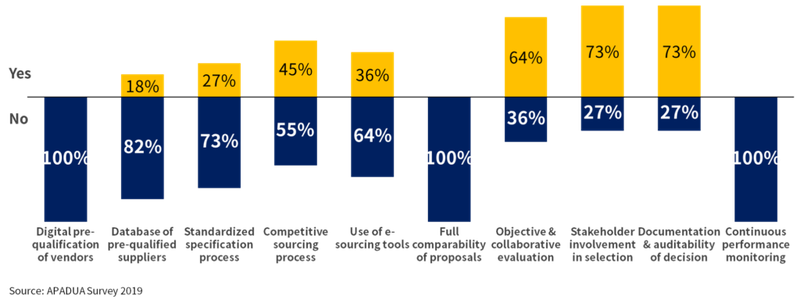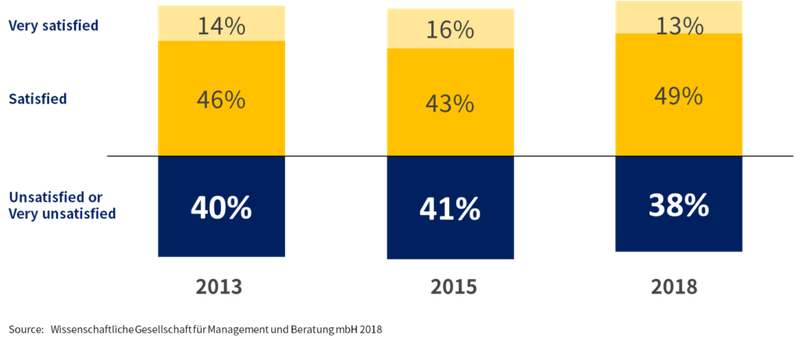
Why online shoppers shop more professionally than large companies and what should change
If you are a private person planning to buy a new dishwasher, the steps to purchase are pretty clear. First, you think about what features the product should have. Second, you conduct online research. Third, you compare individual offers. Finally, you decide on a product and buy it.
A similar process takes place in companies daily. However, it should be noted that when it comes to Professional Services, it is often neither structured nor standardized and certainly not digital. The result of a survey conducted by APADUA in 2019 shows that there is still considerable potential for improvement for many companies with regard to the efficient procurement of Professional Services.
Fig. 1: Use of digital tools in Professional Services procurement 2019

This applies to the entire process from the specification of requirements to the selection of suppliers and comparison of proposals to the placing of orders and continuous performance monitoring.
This negligence has fatal consequences: Customer dissatisfaction with consulting projects is a staggering 38% (WGMB). This success rate of consulting projects is only marginally higher than when tossing coins. To be honest, this is not a very good prospect.
Fig. 2: Customer satisfaction with Consulting Services 2018

Why is that? Instead of questioning their own processes, clients quickly point the finger at their service providers, in this case, the Management Consultants. A lack of competence, high costs, or a poor “personal fit” are then cited as the cause of failed projects.
This means that the total annual economic damage amounts to almost twelve billion Euros in Germany alone. However, many companies have recognized the potential of digitizing their own purchasing processes and are counteracting this trend. In the “Digital Procurement Survey 2019”, PwC shows that the digitalization of purchasing is given high priority. Nevertheless, there is a lack of knowledge about suitable instruments to implement the necessary measures.
Fig. 3: Ranking of procurement priorities 2019

But it really is as simple as it sounds: When it comes to implementation, we could adapt processes that almost every consumer goes through when shopping online these days. Let’s compare the procurement of Professional Services with online shopping.
The dishwasher dilemma
At the beginning of the procurement process, there is a need. A need poorly articulated usually leads to a bad shopping result and customer experience. Therefore, it is important to describe the identified problem as precisely as possible and to create a catalog of criteria to define the exact requirements for the solution sought (product or service).
When buying online, this often takes the form of search masks and filters. In companies, it should be carried out by the respective internal customer and aided by the professionals in the procurement department.
The value of a good demand specification becomes clear when considering the negative consequences of a bad specification. Imagine being supplied with a washing machine instead of a dishwasher. Although the size and efficiency of the device are in line with your requirements and it also fulfills the basic function of “cleaning things”, any attempt to clean your dishes in it would have bad consequences.
In terms of Professional Services, this means that if you do not describe your needs or the problem properly in advance, it is possible that the service you have purchased will not only fail to solve the actual problem but may also cause additional damage.
The description of requirements is followed by searching for a suitable service provider. When buying online, it is common practice to get an overview of the characteristics of different products on comparison portals and to make a pre-selection of potential devices with the help of quality seals.
In comparison, the APADUA survey shows that the selection of service providers at the company level is hardly system-supported. Today, many organizations show a low adoption rate of comprehensive digital solutions available. What is common at the private level could also be used to increase value at the company level.
Currently, the identification and evaluation of potential service providers is often done manually and in a less standardized way. This requires a lot of time and selective evaluation of individual companies and solutions. In order to find the best provider, scouting skills should be built up and processes should be digitized or standardized. Pemer & Skjølsvik (2019) provide one way to achieve a standardized screening process.
Fig. 4: Best practice Professional Services vendor screening process

Comparability? Almost zero
In contrast to online shopping, the RFP process follows the service provider’s preselection. As problems differ from company to company, service providers often provide individual proposals and solutions.
However, an objective comparison of the different concepts and financial offers causes problems for all companies surveyed. Let’s assume that you are looking for your new dishwasher at three online shops. Then let’s assume that the features differ slightly in terms of performance, water consumption, efficiency, noise level, and external dimensions. In addition, there are different prices, delivery, and warranty periods. How can these offers be compared? You use comparison portals or aggregators!
The solution in the context of Professional Services is to create a solid RFP, in which the requirements for an offer are clearly defined. In addition, a uniform catalog of criteria helps to evaluate offers in terms of qualitative and quantitative features. An evaluation matrix prepared in advance ensures the most objective comparison possible. The matrix can vary slightly from project to project. An individual weighting of criteria is useful. The development of a basic template is necessary if similar services are purchased regularly.
As a result, companies receive a detailed picture of the individual offers. The advantage of a standardized evaluation by several experts is that cognitive distortions and subjective preferences are largely eliminated. This process can be mapped digitally.
Performance monitoring? Why not?
If the service provider is mandated, this does not mean that the problem will be solved in the interest of the customer (see customer satisfaction). Clients regularly do not find out that projects are underperforming until results have to be delivered. Then problems become visible.
The APADUA survey shows that many project teams fail to identify target deviations and risks at an early stage and steer the course of the project back on the right track. None of the companies surveyed carry out continuous performance monitoring on their projects.
Here, too, the example of online trading is obvious. Regular surveys by traders are common. In this way, they ensure that their products and processes function well. At the same time, customers share their shopping experience with other interested customers in the form of reviews. This information makes it easier for potential customers to choose the best supplier. Retailers with below-average ratings have to make improvements to avoid being forced out of the market.
The implementation of such a Performance Monitoring is simple and available for Professional Services. Performance indicators (KPIs) are measured with the help of recurring surveys while the project is still running and the results are automatically shared. In this way, an overview of sentiment in the project team is continuously generated and risks can be identified early before they turn into problems.
This real-time data collection provides benefits on two levels: Firstly, deficits in the project can be identified and addressed at an early stage. Secondly, this information helps to uncover the strengths & weaknesses of individual providers, which in turn facilitates the selection of the best partner for future projects.
Same same, but different
Whether dishwasher, washing machine, or Professional Services, it is clear that a structured, digital, and consistently system-supported procurement process helps to find the best provider and thus increases the chances of successful projects.
While today’s consumer naturally integrates digital solutions into the core procurement activities to explore, source, and monitor, many large companies are still lagging far behind.
For the future, it is essential to convince companies of the advantages of system-supported solutions and to motivate them to trust new solution providers and their innovations. In the end, hopefully, this will result in five stars, also for the procurement of Professional Services.
Sources
apadua | Enterprise solution provider for Professional Services procurement
WGMB| Academic research organization for Management Consulting in Germany
PwC | International Professional Services network providing Audit & Consulting Services
Frida Pemer & Tale Skjølsvik | Authors of numerous papers on Professional Services
Co-authors
Gregory N. Vider | Founder & Managing Director at APADUA
Maximilian Stein | Student at University of Cologne / Senior Analyst at APADUA
Author

Since I started in this field over twenty years ago, procurement as a function has changed considerably. Yet, while in direct materials nothing goes without procurement involvement, and its organizational, procedural, and systemic framework is mostly kept up to date, indirect procurement, particularly services procurement, still lags miles behind. We established apadua to offer solutions tailored to the specific needs of services procurement and to close the gap. In all of this, we must remind ourselves: While our business is technology our customers are human.
Latest News
Interested in learning more?
Request a demo and in just 15 minutes we can tell you how Apadua can help your company become better in procurement.

